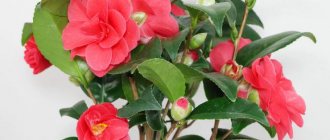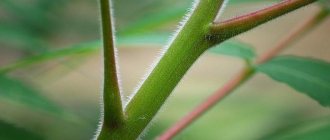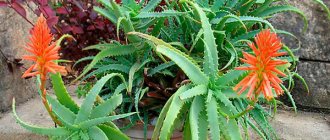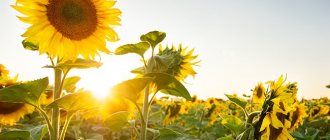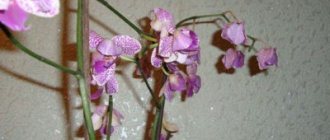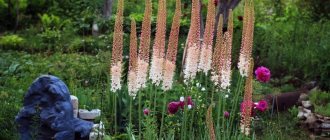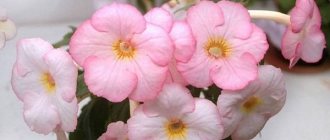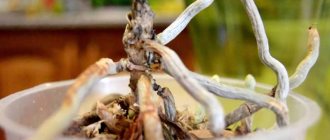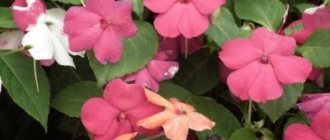The main character of today's article will be that same banana, the fruits of which remind us of the taste of childhood. Many of us, while still children, dreamed of having our own garden of exotic trees, in order to be able to pick a rare fruit in our area at any time and enjoy its pleasant taste. It turns out that this dream, albeit partially, can be realized: many gardeners grow bananas indoors. This exotic plant will delight you not only with delicious fruits, but also with a bright appearance. It is worth noting that banana has a positive effect on the chemical composition of the air and improves the atmosphere in the room.
Banana is a powerful perennial plant that belongs to the banana genus. In the wild it can grow up to ten meters in height. No matter how paradoxical it may sound, bananas are classified as herbs, and their fruits are considered berries.
Bananas prefer tropical and subtropical climates. The plant is native to East Asia and Hindustan. Bananas came to Europe several centuries ago. The sailors liked the taste of these hearty and aromatic fruits, and they began to supply bananas to the Old World.
How do they reproduce?
- using seeds;
- vegetative method.
Vegetative propagation is a faster and more reliable method than seed propagation.
Biologically, the process is as follows: after the plant bears fruit, its above-ground part dies off, and the root grows to the side, creating new bushes. Bananas are propagated by suckers and parts of the rhizome (rhizome). The most tenacious and productive offspring are formed during the fruiting of the mother plant; during this period they have the maximum supply of nutrients. As for planting rhizomes, it is best to use pieces weighing from 1.5 to 2 kg of whole rhizomes dug up from old plantations
Planting is best done at the beginning of the rainy season.
In nature, bananas reproduce using seeds located inside the fruit. At the same time, the wild banana fruit itself is inedible. It can contain from 50 to 100 seeds, sometimes their number reaches 200. Seeds germinate after falling into the ground (for example, when a ripe fruit falls). This takes time, because they are covered with a thick peel. After about 2 months, a green shoot will appear and the plant will begin to develop.
Due to vegetative propagation, cultivated banana varieties do not renew their gene pool, as a result of which they have little resistance to fungal diseases.
Soils with a high humus content and good drainage are best suited for plantation cultivation. If the drainage is poor, then the risk of infection by the same fungi increases many times over. To maintain high yields, it is advisable to use potassium and nitrogen fertilizers.
Where did the banana come from?
Indian travelers saw how bananas grow in nature for the first time in Malaysia. This happened earlier than the 6th century BC, and since then the fruit has often appeared in Buddhist scriptures. Everything indicates that it was during this period that the fruit began to grow “culturally” in India.
In 327 BC. the great conqueror Alexander the Great tried and appreciated their unusual taste. It is believed that it was he who brought bananas from Asia and proposed growing them in Europe. And in the 2nd century BC. The Chinese took up the cultivation of bananas in earnest, although until the 20th century these fruits continued to be considered exotic.
Africa became acquainted with bananas during the difficult period of the active slave trade and Islamic conquests (7th century). And after another 700 years, the places where sweet fruits grow were discovered by the Portuguese, known for their passion for travel. By the 18th century, bananas were no longer uncommon in much of the world.
It must be said that the original, wild banana was significantly different from those that are now grown in countries for export. The size was no larger than a human finger (hence the name, which means “finger” in Arabic).
How does it bloom and bear fruit?
The plant is demanding on temperature conditions. The optimal daytime temperature ranges from +27-35C, and the night temperature should not fall below +25-28C. Even a short-term cold snap can provoke not only the falling of inflorescences, but also the death of the entire plant.
Similar negative consequences can be caused by a decrease in humidity levels. This may cause the banana to stop growing.
Optimal soils are fertile, slightly acidic
Particular attention is paid to weed control, for which they use special compounds, resort to mulching the soil and the help of geese. These poultry actively eat weeds, but are indifferent to bananas
Flowering of the grass occurs after 8-10 months of active growth. By this period, a peduncle emerges from the tuber, which is located underground, and passes through the entire trunk. By the flowering phase, it throws out a peduncle that is complex in structure, externally similar to a large bud. The color is purple, sometimes greenish.
Flowers form in the lower part of the “bud”. They are located in several tiers. At the top are the largest, female flowers, the second tier are smaller bisexual flowers, and at the very bottom are the male flowers, which are the smallest in size.
Despite the difference in size, all flowers have the same structure and include 3 tubular petals and sepals. In addition, there are erect and drooping inflorescences, which depends on the banana variety.
Pollination of female flowers occurs through insects, and this process does not stop even at night, since pollination is carried out by bats in the dark. There are no problems attracting insects, birds, and pollinating mice to banana inflorescences - their nectar is very sweet and aromatic. Over time, when the ovary is formed from the inflorescences, the “bud” begins to outwardly resemble a hand with many fingers.
As they ripen, the “fingers” turn into the well-known slightly elongated fruit with yellow skin. However, at first it is green, but turns yellow as it ripens. The size and appearance of the fruits vary and depend on the variety. During the ripening process, the pulp also changes - it acquires a creamy hue, softness, and juiciness.
From a botanical point of view, the fruits of the banana plant are berries. This is due to the fact that inside the pulp there are seeds arranged in a random or ordered manner. There are no seeds in cultivated fruits, while they are easy to detect in wild ones. However, if you cut the flesh of a cultivated banana lengthwise, you will find small dark spots - these are the seeds.
One inflorescence can produce up to 700 bananas, the total weight of which can reach 70-80 kg. After the fruiting period is completed and the plant is harvested, the false trunk dies off, in the place of which a new one will then appear.
On average, 16-19 months pass from planting to harvest. During the fruiting period, the trunk of the plant is strengthened with supports so that it does not break under the weight of the harvest. Harvesting begins when bananas are 75% ripe. They are cooled and transported. To preserve the freshness of the fruit, special conditions are required - a gas-air chamber with a temperature no higher than +14C. Under such conditions, bananas can retain their freshness and properties for up to 50 days.
Growing and caring for the plant
The banana tree reproduces by vegetative and seed methods. On plantations, the method of dividing the rhizome is used - this way the qualities of the variety are completely preserved. The root shoots are planted after the fruits are harvested. Due to the rapid growth and the presence of many dormant root buds, on an industrial scale, in the event of a hurricane threat, the bushes are pruned.
How to get seeds
To grow a plant, you will need its grains, which are preferably purchased at gardening stores or obtained from fruit purchased in a store. To do this you need to do the following:
- place the berries in a bag until the peel turns black;
- cut the pulp along the fruit to the core;
- extract the seeds;
- rinse well under running water through gauze;
- pour warm water and leave for several days, then rinse again.
But since the fruits are delivered to stores unripe, the seeds may not sprout. You should choose grains that are round in shape; flat ones will not sprout. The next stage is no different for planting both purchased seeds and those obtained independently. First, loosen the hard outer shell and rub it lightly with a nail file or sandpaper.
Germination requires a special substrate - sphagnum. But a mixture of sand and peat (3:1) is also suitable. A layer of drainage is placed at the bottom of the container, then soil 5-6 cm thick, and then each grain is placed in the substrate. The soil needs to be watered abundantly and a greenhouse made of polyethylene must be built. The temperature should be about 30 degrees during the day and at least 20 at night. The first shoots will appear in 2 or even 3 months.
Seedling care
A week after germination, each seedling is placed in a separate pot. Bananas will grow well on soil collected from under linden, hazel, and acacia trees. You need to add to it 2 parts of sand, 1 part of humus and 0.5 parts of ash. A good drainage layer is laid at the bottom. A young seedling penetrates its roots 2 cm into the soil.
Tillandsia - how it blooms, care at home
It is necessary to follow a certain regime for the healthy growth of a banana tree. Care at home consists of regularly loosening the top layer of soil, abundant watering, daily spraying and fertilizing. The plant must be placed in a warm, sunny place. It should also be noted that bananas tolerate dry soil better than excessive watering, which leads to rotting of the root system.
Banana diseases and pests
The tree at home is resistant to diseases. For prevention, it is enough to carry out root treatment with a weak manganese solution once every 6 months. When the foliage turns yellow and curls, it may become infected with a scale insect (appears on the bottom of the leaf as a brown spot). It must be removed manually. Another pest is the spider mite, which can be identified by light spots on the foliage and webs near the stem. In both cases, insecticide treatment is required.
Diseases and pests
Like any plant, bananas can get sick and be damaged by pests. The most common of them:
- small beetles, larvae, which are called nematodes - they penetrate into the middle of the stems and begin to gnaw them;
- black weevils - crawl into the base of the stem, gnawing passages from which juice begins to flow in the form of jelly;
- due to the lack of renewal of the plant gene pool, cultivated varieties have low resistance to fungal diseases.
To combat pests, you can use special plant disinfectants. For prevention, you should not forget to moisten the soil. If the plantations are severely damaged, the infected plants must be destroyed.
Bananas: contraindications and harm
- It is not advisable to eat bananas before bed, or combine them with milk, so as not to provoke fermentation in the stomach and cause intestinal dysfunction.
- People suffering from diabetes are not allowed to eat bananas because they contain little glucose and fructose, but a lot of sugar.
- Bananas can cause harm to people who suffer from thrombophlebitis, as these berries help thicken the blood.
How bananas grow on plantations
The banana plant has a structure characteristic of herbaceous species: powerful roots, a main stem on which there are huge leaves ranging from 6 to 20 pieces. After bamboo, the banana plant is the 2nd tallest plant in the world.
On plantations, bananas can grow with a stem thickness of up to 40 cm and a height of up to 8 m. Their leaves are 50 cm wide and reach 3 m in length, and they begin to grow not on branches, but from the depths of a hollow trunk, which is a characteristic feature of herbaceous plants. Having reached a certain height, the leaves begin to bend downwards from their own weight.
The powerful root system can be buried in the soil to a depth of up to 1.5 m and a width of up to 5 m in all directions. Each rhizome can live from 2 to 5 years, producing new shoots every six months. A characteristic feature of the structure of the leaves is a long longitudinal vein located in the center of the plate. The color depends on the plant variety and can be either green or with spots of burgundy or crimson.
The fruits grow in clusters, each containing up to 100 pieces. bananas Maximum productivity on plantations is achieved with high air humidity. In some areas, they even use a layer of polyethylene to wrap the ripening bunches to increase humidity and speed up the ripening of the fruit. However, this threatens the rapid emergence of fungal infections and diseases.
How to grow in open ground, where and under what conditions is this possible?
As already mentioned, banana grows mainly in the tropics. In Russia it grows south of Sochi, but does not bear fruit due to the harsh winter. There is a frost-resistant variety of banana palm, planting and caring for it in open ground does not require much expense. The name of this variety is Japanese banana.
Frost-resistant Japanese banana variety – Musa Basjoo
Watering is daily, excluding, of course, rain. Don’t forget about humidity, so on hot days you can also use sprinkling. To maintain soil moisture longer, mulching is also a good idea.
Important! This banana, of course, will not bear fruit, but will attract attention with its unusual “tropical” appearance. When the growing season is over and the leaves fall off, it is necessary to cover the stem for the winter and cover it with soil. In this form it can withstand frosts down to – 25 °C
In this form it can withstand frosts down to – 25 °C
When the growing season is over and the leaves fall off, it is necessary to cover the stem for the winter and cover it with soil. In this form, it can withstand frosts down to – 25 °C.
To grow a banana at home, you will have to try. But it’s worth it, because these plants will add a touch of originality and unusualness to the interior of any apartment.
Banana tree grown at home
An exotic plant can be recognized by the following characteristics:
- in tropical climates, banana trees reach 12 m in height, but at home they do not grow higher than 2 m;
- the length of the sheet reaches 2 m, and the width can be 1 m;
- the bases of the leaves fit tightly to each other, due to which a pseudostem is formed;
- the stem itself is underground, it also performs the functions of a root;
- inflorescences are formed in the middle of the ground stem and always die off after flowering.
Interesting! The banana tree is called a “tree” only because of its external resemblance. In fact, banana is a herbaceous perennial. Its terrestrial part lives no longer than 40 years.
There are several varieties of bananas that can be grown at home. Some of them, with proper care, are capable of bearing fruit:
- Pointed Banana;
- Cavendish is a dwarf;
- Cavendish is a super-dwarf;
- Kyiv dwarf;
- Kyiv superkalik.
Indoor pointed banana with fruits
In addition to fruit-bearing varieties, decorative indoor varieties are also grown:
- Velvety;
- Lavender;
- Chinese dwarf;
- Bright red.
Attention! To grow an ornamental variety, you can simply buy seeds. For fruit-bearing species, it is better to purchase ready-made seedlings
Chinese dwarf banana
Banana varieties for home cultivation
If you want to grow bananas at home, pay attention to these varieties:
- Velvety banana is a houseplant that is considered one of the most popular representatives of the banana genus. The velvet banana usually grows up to 150 cm. It gets its name from the velvety fruits that sprout from bright yellow flowers.
- Lavender banana is an aesthetically very valuable species that boasts bright lavender or orange inflorescences.
- Red banana - rarely grows above one meter. Distinctive features: bright scarlet flower, oblong green leaves.
Useful tips:
- Since banana is a tropical plant, it must be kept in conditions of elevated temperature and humidity;
- In order for the plant to develop normally, it must be regularly fed with special preparations. It is worth noting that some fertilizers can be prepared independently;
- You can keep the plant compact by pruning, which must be done with a sharp and disinfected tool. If you are not confident in your competence, it is better to entrust pruning to professionals.
Indoor banana is a very beautiful plant that can become a key element of your interior. We hope that our article has become as useful as possible for you, and now you know how to grow bananas indoors.
Rate this post
What kind of plant is this?
A banana is a herbaceous plant on which the fruits of the same name ripen. Even though the plant looks like a tree, it is a grass. Moreover, it is quite tall, the second tallest after bamboo.
Banana grass is called because of the absence of wood on the above-ground part of the plant. In fact, the trunk (it would be more correct to say “false trunk”) is formed by the leaves superimposed on each other. It is not surprising that in this case it does not have growth rings and branches. Over time, the banana leaves that form the trunk dry out, acquire a brown tint and, indeed, resemble a trunk more and more.
The herb belongs to the banana family, genus banana. It has branched rhizomes that spread over a distance of up to 5 m and can go 1-1.5 m deep into the soil. The banana is often called a tree because of its high false trunk, which reaches 2-12 m and has a diameter of up to 40 cm.
The banana also boasts impressively sized leaves - they reach 3 m in length and 1 m in width. These are “ovals” with a pronounced longitudinal vein and many thinner veins extending from it.
By the way, during a strong wind, the leaves tear along the veins, which reduces the pressure on them and eliminates the threat of the plant being torn out of the ground by a strong gust of wind.
Leaf color can vary significantly depending on the plant variety. There is grass with dark and light green leaves, sometimes with purple spots on top of the green color. There are varieties that are characterized by two-color leaves - they are crimson below and bright green above.
These huge leaves have a waxy coating on the outside, which prevents excessive evaporation of moisture from the leaves. As they age, the leaves fall off, and in their place new ones appear from the axils of the trunk. On average, it takes a week for a new leaf to develop.
The plant is often called a banana palm, due to some external similarity between the plants. However, such a classification is erroneous - the banana has nothing in common with palm trees.
The banana grows in areas with a tropical and subtropical climate. The world's largest suppliers of bananas are Pakistan, India, China, Thailand, Bangladesh, and Brazil. Under natural conditions, it is possible to grow the crop near Sochi, but winter temperatures here are still too low for it.
Today, about 70 varieties of bananas are known, all of them can be classified into one of three groups.
Decorative
These plants are cultivated not for their fruits (they are inedible), but for their attractive appearance, especially during the flowering period. In addition, the leaves and elements of the false trunk are used in industry - they are used to make car seats and fishing gear.
Among the most famous ornamental varieties are the following:
- “Pointed banana” has beautiful dark green leaves with serrations, thanks to which the leaf resembles a bird’s feather, bears fruit in warm climates, and the fruits can be eaten;
- The Blue Burmese Banana has an attractive silver-coated purple-green trunk, rich green leaves, and purple or blue-skinned fruit.
Plantano
Bananas of this variety grow large and are suitable for eating, but usually require heat treatment. Such fruits are fried, baked, deep-fried, dipped in batter. By the way, it is from these varieties of bananas that banana chips are made.
Since platano fruits are quite dense, they are subjected to heat treatment, but the ripe peel can be eaten fresh. To do this, you should choose sycamore with black peel.
Unlike dessert bananas, platanos have denser, unsweetened flesh and a dense skin. In addition to being eaten, they are grown as livestock feed.
In turn, bananas of the platano variety are divided into 4 groups - French, French carob, false carob and carob.
Dessert
Bananas are well known in our country and can most often be found on store shelves in fruit departments. They are consumed fresh, but the pulp of such bananas can also be dried and dried.
Among the most famous dessert varieties are “Paradise”, “Gros Michel”, “Ice Cream”. Miniature bananas are the “Lady Fingers” variety (fruit length is 10-12 cm).
Types and varieties
Although there are disappointingly few varieties of this fruit on Russian shelves, in the world their number is measured in dozens. Fruits vary in shape, color, size, taste, and calorie content. Some types contain oil that is actively used for cosmetic purposes.
There are subcategories according to which banana fruits are divided into narrower groups.
Decorative
An inedible banana can grow in an apartment, serving as an ornamental plant. The appearance is spectacular - it is a tall lush tree with a green mass of leaves, up to 2 meters high. It bears fruit, but the fruits are green and hard. The most common varieties of ornamental bananas are lavender, bright red and velvety.
Sycamore plantains
Plantain is the so-called “vegetable banana”. In many respects, the variety is similar to a regular dessert fruit, but it grows and is consumed in other ways. Plantain is bred artificially as a cheap high-carbohydrate food for poor countries in the world.
The tree grows larger and more stable, and reacts less to drought. At the same time, plantain grows well and bears fruit in a humid climate and saturated developed soil.
Dessert bananas
Dessert fruits grow yellow and are used in food without prior heat treatment. In addition, they can be prepared dried or dried. The most popular variety of this type is the paradise banana. The height of the plant reaches a length of nine meters. The leaf size is up to two meters in length, the leaves grow bright green with highlighted brown spots.
The fruit itself is usually five centimeters in diameter and up to twenty centimeters in length. The pulp is tender, dense, almost white, without seeds. Up to 300 fruit units grow on one stem. These are the fruits we see in stores. They all grow as a result of artificial selection.
How to distinguish fodder bananas
In Russia, the only fodder variety is considered to be the above-mentioned plantain. The name is always indicated on the box. If the packaging is not in sight, food fruits can be distinguished by their size (long, large, at least 4 cm in diameter) and by pronounced longitudinal “ribs”.
This species is collected and sold immature because they turn black when mature. Plantain fruits are more starchy, and therefore have a higher calorie content.
Care
But it’s not enough to just sprout a banana. To prevent him from dying prematurely, he needs special care. Key Features:
Temperature
Bananas are native to the tropics, so the appropriate temperature should be observed. Cold is contraindicated for this resident of warm countries. In summer, the optimal temperature will be 26-30 °C, in winter - 18-21 °C.
Note! There are varieties that can survive the winter even when grown in open ground. It is enough to trim the plant so that about 10 cm remains on the surface and cover it with sawdust
But this is only suitable for regions with warm climates.
Spraying and watering
In an apartment it is difficult to achieve the conditions in which a guest from the tropics is accustomed to growing up. It is necessary to ensure humidity up to 65%, which is difficult to do, especially during the heating season. Therefore, it is recommended to spray the banana at least four times a day, in winter you can twice and wipe the leaves with a damp cloth.
Important! If possible, you can place a humidifier nearby. For homemade bananas, the soil needs to remain moist at all times.
It is recommended to water it 2-3 times a day in the summer; in winter, once a week will be enough. Additionally, you can remind the plant of its homeland with constant tropical downpours and water it in the shower
For homemade bananas, the soil needs to remain moist at all times. It is recommended to water it 2-3 times a day in the summer; in winter, once a week will be enough. Additionally, you can remind the plant of its homeland with constant tropical downpours and water it in the shower.
If you do not comply with these requirements, the leaves will begin to turn yellow, fall off, and it will be very difficult to revive the tree.
Lighting
The home banana loves bright sunlight. Ultraviolet radiation has a direct effect on its growth and development. Therefore, for proper care, it is better to place the plant on windows facing the sunny side of the house, but in particularly hot weather put it in the shade. If the tree is constantly in the shade, then it will stop growing, flowering, and you can no longer expect fruit from it.
Banana Lighting
Priming
It is best to choose a breathable growing medium with neutral acidity. A soil with these properties is available in most flower shops. If there are no such mixtures nearby, then you can make your own by mixing peat, sand, turf and leaf soil. Additionally, you can use additives to increase soil looseness.
Fertilizers
During the period of active banana growth at home, additional fertilizer is necessary. For this purpose, organic additives are used in diluted form. They should be applied once a week immediately after watering. After this procedure, the plant should be left in the shade for a day.
One of the interesting features of the banana tree is the absence of such a dormant period, which is typical for some plants. However, conventionally, this period is considered to be the winter season. With the onset of cold weather, the tree is given the opportunity to rest: kept at a temperature of about 20 ° C, watered and fertilized less often.
banana pruning
After the rest period, the flowering phase begins. But you shouldn’t expect a harvest in the first year. With proper care, banana fruits grown from seedlings will appear in two years, from seeds - in four.
If, first of all, you need not fruits, but a beautiful tree, then you can use the pruning method. As a rule, it is not recommended to do this at home, but if initially the banana does not please the eye with lush greenery, then pruning at the root will allow new shoots to appear.
Growing problems:
- Brown leaf edges and drying indicate frequent watering, as a result of which the banana roots have rotted. It is also possible for the plant to stop growing and developing even under favorable conditions. Urgent replanting and removal of damaged parts of the root system and sprinkling with activated or charcoal are necessary.
- The leaves dry out and there is no shine on the foliage due to low air humidity.
- Yellowing of foliage occurs when the temperature drops to unfavorable levels.
Views: 1,914
Fruit bananas (the fruits of which can be eaten)
Grown for its abundance of tasty fruits. Developed from two known species: Banana Balbis and Banana acuminate. Popular varieties are:
A low-growing variety with dense pale green leaves. The flower is bright red. Fruits abundantly.
Dwarf Cavendish banana (Musa acuminate Super Dwarf Cavendish)
Low fertile variety. The bright green leaf blades are wide and large. Burgundy flower.
It is still rarely found in apartments. Fans of indoor exotics like the plant with its powerful silhouette, large leaves and spectacular flowers. The giant plant looks good in a spacious room with high windows. Large space allows the plant to develop harmoniously and emphasizes its uniqueness.
Banana composition, vitamins and minerals. What are the benefits of bananas?
Bananas are considered low-fat, but quite nutritious and energy-rich foods. The pulp of its raw fruits consists of a quarter of carbohydrates and sugars, and a third of dry substances. It contains starch, fiber, pectin, proteins and various essential oils, which give the fruit a characteristic aroma. Banana pulp contains useful minerals and vitamins necessary for the human body: potassium, magnesium, phosphorus, calcium, iron, sodium, copper, zinc, as well as vitamins B, E, C and PP . Thanks to its unique chemical composition, the plant has found application in medicine.
In what countries do they grow?
Banana is one of the oldest plants cultivated by man. As Russian scientist Nikolai Ivanovich Vavilov established during his many years of research, its homeland is Southeast Asia and the Malay Archipelago. In this section we will look at where the banana grows and in which countries it is produced most.
In what countries do bananas grow? Nowadays, they are grown in at least 107 countries in Asia, Latin America and Africa with humid and tropical climates. It is used as:
- food product (fresh and dried);
- base for making banana beer and wine;
- raw materials for fiber production;
- ornamental plant.
Of course, the main purpose of banana fruits is to eat. The leader in the consumption of these fruits per capita is the small African country of Burundi - here each citizen eats almost 190 kg per year. It is followed by Samoa (85 kg), Comoros (almost 79 kg) and Ecuador (73.8 kg). It is clear that in these countries this crop is one of the staple foods. For comparison: on average, each Russian consumes just over 7 kg of bananas annually.
Banana crop ranks 4th in the world among cultivated plants, after rice, wheat and corn. This is not least due to its high calorie content - 91 kcal per 100 g of product, which is higher than, for example, potatoes (83 kcal per 100 g). The only drawback is how long it takes for a banana to grow. After all, before flowering begins, you need to wait 8 or more months until the plant itself ripens.
The export of bananas, which became possible with the advent of refrigeration units at the beginning of the 20th century, over time turned into a highly profitable business and remains so in our time.
The list of leaders in banana production for 2013 (in millions of tons) looks like this:
- India (24.9).
- China (10.9).
- Philippines (9.3).
- Ecuador (7).
- Brazil (6.9).
Banana products are imported mainly from European countries, the USA and Canada. The leader in this direction, the United States, purchases almost $2.5 billion worth of bananas every year.
Here you should immediately answer the common question “Do bananas grow in Africa?” As noted, they are native to tropical and humid countries, so yes. However, there are not as many of them here as in Asian and Latin American countries - the leader on the African continent is Tanzania, which produced 2.5 million tons in 2013.
How many calories are in a banana?
Data per 100 grams of product:
- calorie content of green banana – 89 kcal;
- calorie content of a ripe banana – 110-120 kcal;
- calorie content of an overripe banana – 170-180 kcal;
- calorie content of dried banana – 320 kcal.
Since bananas vary in size, the calorie content of 1 banana varies between 70-135 kilocalories:
- 1 small banana weighing up to 80 g and up to 15 cm long contains approximately 72 kcal;
- 1 medium banana weighing up to 117 g and more than 18 cm long contains approximately 105 kcal;
- 1 large banana weighing more than 150 g and more than 22 cm long contains about 135 kcal.
Energy value of a ripe banana (ratio of proteins, fats, carbohydrates) (data per 100 g):
- proteins in banana - 1.5 g (~6 kcal);
- fats in banana - 0.5 g (~5 kcal);
- carbohydrates in a banana - 21 g (~84 kcal).
It is important to note that bananas do not cope well with hunger, increasing it after a short-term satiety. The reason lies in the significant sugar content, which rises in the blood and after a while increases appetite.
Food served on banana leaves in India
Interesting Facts
For residents of northern latitudes, not only what a “banana palm” looks like is educational, but also in what areas of their life a person can use this unique plant, how it is eaten, and many other facts are also interesting.
- In India, a very unusual use was found for the banana. When launching a ship into the water, the launching surface must be lubricated. For this, lard, paraffin, grease or other substance is used. Residents of India sometimes lubricate their slips with bananas. In order for a medium-sized ship to float, you need to take about 20 thousand fruits.
- Eating one banana is enough to provide a person with the daily requirement of potassium and magnesium.
- Black spots on banana peels are completely harmless. They say that the berry is ready for consumption and its further storage is undesirable.
- Not only the roots, but also the leaves of the plant help bananas to withstand strong winds. Under extreme conditions, leaf plates tear along the vein lines, thereby reducing the wind pressure on them.
The banana fruits that hit the shelves of Russian stores have undergone a long sea voyage. And it began in one of the 100 countries in the world where the crop is cultivated today.
What do bananas grow on? Ask the baby and you will hear in response that it is on a palm tree. But the children will say that. And those wise from life experience, scratching their heads, will say: “A banana grows on a banana tree, but it is not a tree at all, but a real grass, tropical and tall, like a tree.” And they are right, it is actually grass, although it looks like a tree.
Firstly, the banana does not have a trunk in the traditional sense, that is, it is a grass. And what looks like a trunk up to 6 m high (sometimes 9 - 10 m, why not a banana tree) are powerful leaves rolled into a tube. They begin to grow almost from the ground, and stretch upward together. And when 30-40 leaves grow, a peduncle appears inside the bundle, which also wants to go to the sun. And so he finds himself at a height of several meters.
Secondly, banana fruits are berries (according to the botanical classification), but berries, after selection, almost without seeds. There is one for every 250 bananas. Therefore, they are grown vegetatively. Even dried rhizomes do not lose their viability and grow after planting and watering. The settlers often used this and they knew well what bananas grew on. These fruits are used as dessert, in the form of flour, dried, pickled, fried, steamed, etc. After all, this is everyday food in Latin America, Africa, and Asia. Even the Germans eat up to 20 kg of bananas per person per year. And America is only 18 kg. But in Germany, from 1933, the Nazis began to need all the currency in the country, and since bananas did not grow there, they had to start anti-banana propaganda. “A small child died after eating bananas; a man who ate too many bananas was taken to hospital; “We are not monkeys, German strawberries are better than African bananas.” The film “Why is a Banana Yellow” was even banned, etc. But after the war, American bananas became a symbol of prosperity. And in 1995, Europeans introduced an international standard for “Eurobananas”. And the Americans who transported bananas to Europe do not fall under this standard - they are smaller in size. And although the Germans know what bananas grow on, competition is competition.
Thirdly, young banana plantations need to be weeded, and this is difficult to do under the scorching sun. Whereas in ancient Rome, geese were called to help because they ate weeds and did not touch bananas - they did not like them.
Kiev resident Anatoly Patiy also knows what bananas grow on in his garden. He has been growing them in a greenhouse for more than one year, and manages to get a “Kyiv Dwarf” harvest of up to 300, or even 400 fruits per plant, which is no less than 50 kg. The height of the “Kyiv Dwarf” grass is no more than 1.7 m, and the “Super Dwarf” is even lower - up to 1 m. They grow and bloom in a greenhouse at + 15–16 degrees Celsius. The size of one banana is up to 15 cm. A dwarf is a dwarf.
Bananas must be peeled before eating. Banana peels were used only in comedies, so that the hero would slip on it and fall in a very funny way. Now it is used in cosmetics, including for the removal of warts.
Banana peels, thoroughly dried, contain large amounts of tannin, a coloring agent for black leather products.
But the Brazilians went further. G. Castro (not to be confused with F. Castro, R. Castro and V. Castro) uses crushed peel to purify drinking water from copper and lead in 10 minutes and eleven times in a row. And Milena Boniolo from the state of Sao Paulo uses powder from the peel to clean industrial wastewater. And they don’t have enough of this goodness.
Beneficial properties of banana. Uses of bananas
So what are bananas good for?
- Banana pulp is used to relieve inflammatory processes occurring in the oral cavity, and also as a dietary product in the treatment of stomach and duodenal ulcers. In addition, banana is a laxative and is therefore used as a mild laxative. Due to the presence of tryptophan, an amino acid that prevents cell aging and has a beneficial effect on brain function, bananas are recommended for consumption by older people. The presence of potassium and magnesium allows them to be used as a means of preventing high blood pressure and stroke.
- Banana flower infusion helps in the treatment of diabetes and bronchitis. The juice obtained from banana stems is a good anticonvulsant and sedative.
- The invaluable benefits of bananas are concentrated in the peel. Banana skins are used for medicinal purposes. Compresses from young leaves or banana peels promote rapid healing of burns and abscesses on the skin.
- Banana peels are used as fertilizer for both indoor and outdoor flowers. The fact is that it contains a large amount of phosphorus and potassium. Using banana peels you can also fight aphids, which cannot tolerate excess potassium. To do this, you just need to make a tincture on banana skins and water the plants with it. The easiest way to use banana peels to fertilize flowers is to simply bury them in the ground. To do this, just cut the peel into small pieces. After this procedure, even the most tired plants begin to leaf out and bloom. Banana peels take 10 days to decompose in the ground, after which bacteria eat them.
- The benefits of bananas are invaluable: even overripe bananas produce a very powerful antioxidant that prevents cancer.
Residents of countries located in temperate latitudes enjoy eating raw peeled bananas as a dessert and adding them to ice cream and confectionery. Some people prefer dried and canned bananas. This berry is also fried and boiled with or without the peel, adding salt, hot spices, olive oil, onion or garlic. Bananas can be used to make flour, chips, syrup, marmalade, honey and wine. In addition to the fruit, banana inflorescences are also eaten: raw inflorescences are dipped in sauce, and boiled ones are added to gravies or soups. Starch is prepared from unripe banana fruits. Boiled waste from vegetable and dessert bananas is used as feed for large and small livestock.
The fruits and other parts of the banana are used:
- in the leather industry as a black dye;
- in the textile industry for the production of fabrics;
- for the production of especially strong marine ropes and ropes;
- in the construction of rafts and the manufacture of seat cushions;
- as plates and trays for serving traditional South Asian dishes in India and Sri Lanka.
How to make banana leaf plates
Banana fiber
How does banana grass grow and bear fruit?
Despite all the efforts of breeders, it was possible to develop only a few varieties that can bear fruit at temperatures below 10 degrees. All other varieties, and there are more than two hundred of them, simply fall asleep at temperatures below 16-10 degrees, almost completely ceasing their vital functions.
The fruits of banana plants grow in one large cluster on a stem that grows between the leaves of a false trunk, rather than on the top itself, like coconuts. One such bunch can contain from several tens to several hundred fruits, depending on their size and type.
The opinion that a banana is a fruit is fundamentally incorrect, because only tree fruits are considered such. But berries are already growing on the bushes and grass. Therefore, bananas are typical berries, along with raspberries, currants or strawberries.
